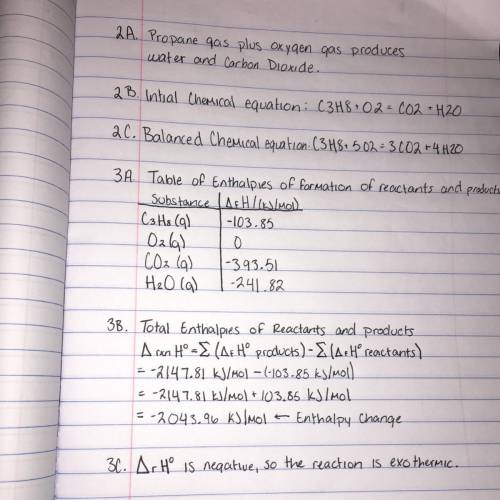
Chemistry, 09.02.2021 20:50, GreenHerbz206
Please help! The picture is what I have so far, I just need help with steps 4 and 5.
Step 4: Model the energy change in the reaction.
a) Create an energy graph that illustrates the energy change in the reaction.
b) Construct your graph on a blank sheet of paper. Be sure to label the axes, provide a title, and
identify the reactants and products on the graph.
Step 5: Explain the energy change in the reaction.
a) Create a new blank document. Type your name at the top.
b) Write a few paragraphs describing the chemical reaction and explaining the energy change in
the reaction. Your document should:
i. identify the reactants and products.
ii. describe the change in energy that occurs as bonds are broken and formed.
iii. identify how the potential energy of the reactants compares to the potential energy of
the products.
iv. state and explain the net change in enthalpy.
v. identify whether the reaction is endothermic or exothermic.
vi explain how energy is conserved between the reaction and the surrounding
environment.


Answers: 1
Other questions on the subject: Chemistry

Chemistry, 22.06.2019 01:30, arodavoarodavo
The table lists pressure and volume values for a particular gas. which is the best estimate for the value of v at p = 7.0 × 103 pascals?
Answers: 3


Chemistry, 22.06.2019 14:00, hammackkatelyn60
The content of manganese (mn) in steel was determined spectrophotometrically and with the use of the standard addition method. an unknown sample of mn from a digested steel sample gave an absorbance of 0.185 when analyzed spectrophotometrically. when 5.00 ml of solution containing 95.5 ppm mn was added to 50.0 ml of the unknown steel solution (digested sample), the absorbance was 0.248. calculate the concentration, in parts-per-million (ppm), of mn in the digested steel sample solution.
Answers: 3

Chemistry, 23.06.2019 03:30, memester74
Scientists often deal with numbers that are either very large or very small. for example, the radius of the sun is approximately 696,000 kilometers, while bacterial cells are as small as 1.9 × 10-4 millimeters. express each of these numbers in an alternate form.
Answers: 3
Do you know the correct answer?
Please help! The picture is what I have so far, I just need help with steps 4 and 5.
Step 4: Model...
Questions in other subjects:

Chemistry, 06.12.2021 05:30






Chemistry, 06.12.2021 05:30



Law, 06.12.2021 05:30






